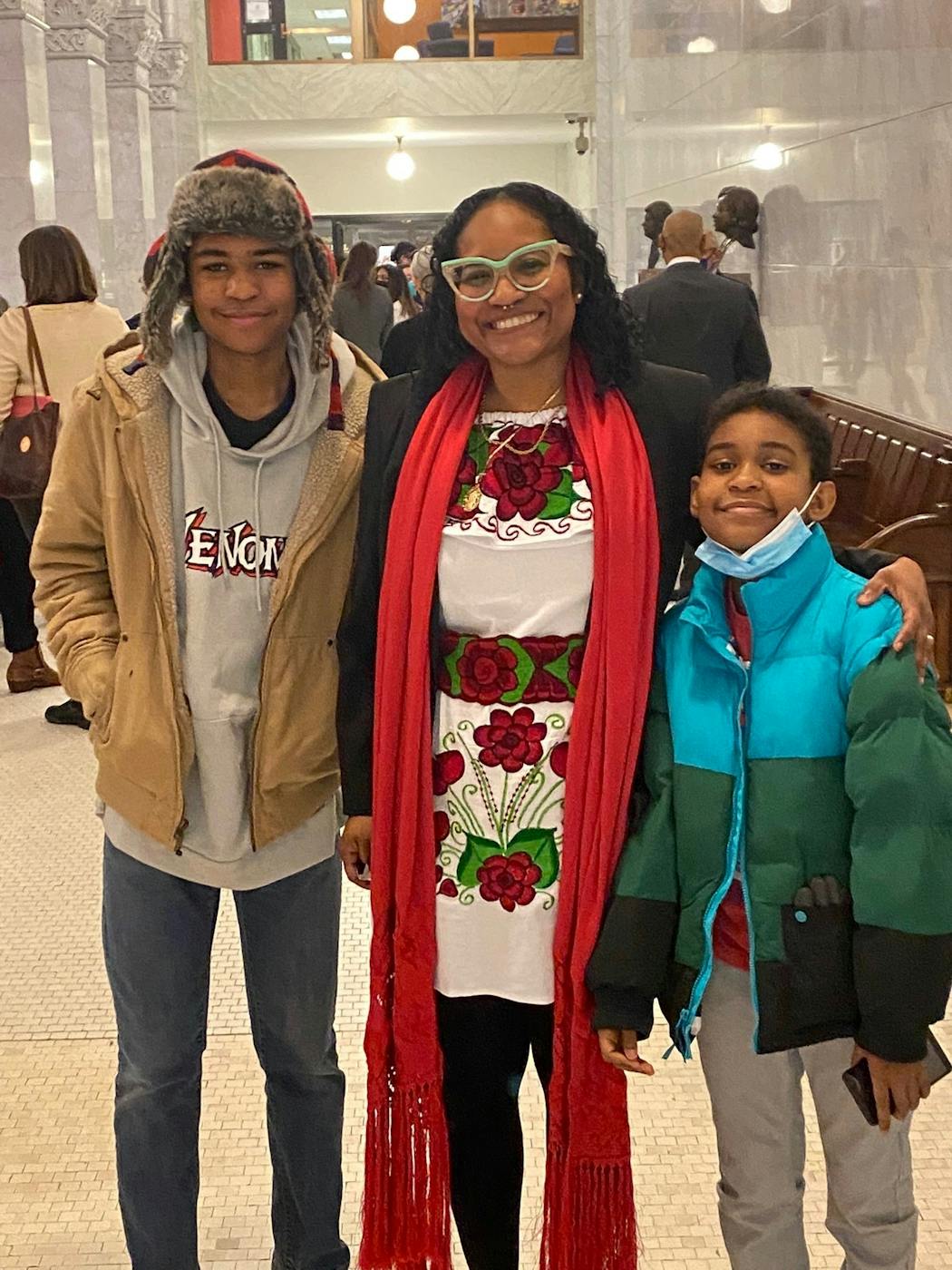Gabriel Stinson was just 3 months old when his mother, a U.S. Army sergeant and combat medic, was deployed to Afghanistan.
Gabriel was 15 when he texted his mom while holed up in a Starbucks at the Mall of America during an active-shooter lockdown. A gunman had just shot two people.
"I'm kinda scared ngl," Gabriel typed. (That's "not gonna lie" for us old people.)
Their texts from that early Dec. 31 evening are filled with confusion and dread. No mother and son should ever have to fumble their thumbs while typing those panicked, frightened words.
His mom, Samantha Pree-Stinson, pleaded to know where he was. Gabriel texted, "Don't call," not knowing if the shooter would hear the ring. Pree-Stinson admits she committed the ultimate parent offense in which she mistakenly dialed him anyway. She followed it with a text that read: "God is watching over you and I'm coming."
When Gabriel first started texting her, Pree-Stinson was in the shower of her northeast Minneapolis home, which is why, when she arrived at the mall minutes later, she still had shampoo and conditioner on her head.
"You want nothing more as a parent than to bust through those doors," she told me.
She reunited with her son in the parking lot, but only after witnessing an uncontrolled scene that she finds unacceptable. When she and her friend rolled up to the mall, people were coming and going — some running out in fear and others with baby strollers obliviously walking toward an entrance.
It goes without saying that there's nothing acceptable about a person opening fire in the nation's largest shopping mall. But Pree-Stinson says we need to prepare for public shootings, as they are no longer unthinkable. The Mall of America and other institutions bear responsibility to get it right.
While serving in Afghanistan, her unit was involved with humanitarian efforts and rescue missions. She remembers responding to instances of mass casualties and injuries, an experience that taught her that "organization and communication is everything."
Gabriel's account of what happened inside the mall was even more upsetting to his mom than what she saw from the outside. When the lockdown began, he was in the Amazon store. Staff closed the shop but told customers it was just a drill. Just minutes into the lockdown, they let Gabriel and other shoppers leave the store.
"That, to me, is a complete failure," she said, citing the apparent lack of communication between the mall and its tenants.
She commends Bloomington police, which last week announced they arrested an 18-year-old who authorities believe was the shooter. But Pree-Stinson says the mall should have clearly informed store staff what was happening and what was expected. "For years we've heard that they've got top-notch security — some of the best security in the world," she said. "It is very odd to me that they had this very poor response."
Mall officials have been tight-lipped about how they think they handled the situation and whether they'll change their policies. Early news reports quoted them reminding the public that the mall conducts monthly lockdown drills. The mall bans guns from its premises but does not screen shoppers for weapons.
In response to a set of questions I asked mall spokesperson Dan Jasper, he wrote that the mall will learn what it can from the shooting.
"Anytime there is an incident at Mall of America, we review our response and actions to learn how we can improve readiness and safety. We are doing that following [the Dec. 31] incident and will apply any lessons in how we communicate with and support our tenants, employees and guests. At this time, that is all we have to share."
Jillian Peterson, a Hamline University professor who studies mass shootings and violence in society, agrees with Pree-Stinson: Communication is paramount.
"The one thing we see over and over again is when things go poorly, it's because of a lack of communication," she told me. "It's because people don't know what's going on, which makes things extra terrifying. Being huddled in terror, not knowing if there's a perpetrator around the corner, or if it's a drill, or if it's real — that has real, long-lasting impact on people."
After Gabriel left the Amazon store with his friends, they found refuge in the back of a Starbucks. It didn't dawn on him how serious the situation was until he saw fellow shoppers crying. He received a few updates from a friend who was checking Twitter from his phone. Gabriel says one of the grown-ups, hoping to defend the group, took up what looked like a knife from the Starbucks kitchen and moved to the front of the store.
When Gabriel texted his mom to not call, it was because "I didn't know how quiet we needed to be," he told me. "We didn't know if there was a certain target for these guys, or if they're just mowing people down."
His outing at the mall on New Year's Eve was an annual winter break tradition with a handful of friends he's known since preschool. After they came home, they decided to have a sleepover to process what they had just experienced.
For his mom, trust with the Mall of America has been broken. As a child born in the 1980s, she "grew up in the mall," spent her money in the mall, worked at the mall, and even met her future husband there. But she was pleased how her son responded to the chaos, even if she wishes he hadn't had to do it in the first place.
"I told him, 'I'm proud of you that you kept calm. You kept your wits about you. You were aware of your surroundings, you made smart decisions.' "
It's a lot to ask a 15-year-old to keep his wits about him in an active-shooter lockdown. It's a lot to ask the teens working in the stores to become leaders in a moment of crisis.
But the mall is well out of its teen years, and much of its life has been lived in the age of a an awareness of Sept. 11 and Columbine. Lapses like those encountered by the Stinson family are unworthy of an institution that prides itself on being the biggest and the best.
Teenagers who work or shop at the mall shouldn't have to rely on their wits alone when their survival may be at stake.

Yuen: Why do people forgive? It's messy, complex and 'the best form of self-interest'

Your fridge is a place where fresh food goes to die. That doesn't have to happen.

Yuen: Parents, let's make a pact to get our kids off their screens and back to real-life play

Yuen: He donated his sperm to friends. Now he wants to be dad to the 5-year-old.







